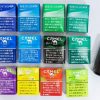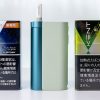After the intensive policy release last month, on December 2, the collection of opinions on e-cigarette management measures was finally released, which also means that the regulatory rules on e-cigarettes will be completely sorted out in 2021. It is expected that the Chinese national standard will come into effect in the middle of next year at the latest, and there will be evidence and laws to follow for the quality of e-cigarettes in the future.
Heat not burn reference regulations:
The “Decision of the State Council on Amending the Regulations on the Implementation of the Tobacco Monopoly Law of the People’s Republic of China” (State Order No. 750) was promulgated and implemented on November 10, 2021. In accordance with the newly revised “Regulations on the Implementation of the Tobacco Monopoly Law of the People’s Republic of China”, in order to do a good job in the supervision of electronic cigarettes, perform supervision duties in accordance with the law, standardize the order of the electronic cigarette market, ensure the health and safety of the people, and promote the legalization and standardization of industrial governance. The bureau has researched and drafted the “Administrative Measures for Electronic Cigarettes (Draft for Comment)”, which is now open to the public for comments. Please provide feedback before December 17, 2021.
According to the interpretation of the “Administrative Measures”, heat-not-burn does not belong to the category of electronic cigarettes, which is suitable for the management measures of traditional cigarettes. In the future, the employment of e-cigarette holders has been basically clarified.
*For more details, please refer to the “Opinions”
There are many types of new tobacco products, and the market share is not large, but they are developing rapidly. At present, the more common “heat-not-burn tobacco products” on the market include IQOS from Philip Morris International, PLoom from Japan Tobacco, Revo from Reynolds Tobacco, Glo from British American Tobacco, and Xiangyu from China Jiyou. It is IQOS under Philip Morris International that really pushes the new tobacco products into the public opinion. As an emerging product in heat not burn tobacco products, IQOS swept the Japanese market soon after its launch. Then the National Bureau announced that from July 1 this year, heat-not-burn tobacco products will be included in the scope of tobacco monopoly management.
As soon as the “Opinions” came out, the development prospect of HNB became clearer.
The current use of heat-not-burn pods is tobacco pods, and the management methods have long been clarified, see the cigarette management methods; the second is herbal pods, and products without nicotine are not included in this management method.
Intense market competition
In the future, more heat-not-burn will be dominated by China Tobacco Company, and it can be seen that domestic heat-not-burn is already gearing up, and the market is about to explode. In order to seize the opportunity, many brand owners have moved closer to the “cake” of heat not burn, which will also face the problem of too high industry saturation and too low penetration rate. So how should businesses strategize in the battle?
Terminal sales supplemented, online sales mainly
Before the New Deal came out, the online “Reform”, which was limited for 18 years, almost completely banned the sale of electronic cigarette products, and the reserve products of relevant industrial enterprises could only promote their products through “testing” and “research”. The product is tested by the method of buying cigarette sets and giving special cigarettes, but once the cigarettes are consumed, they will inevitably face the dilemma of unsustainable consumption. After the boots have landed, it is not difficult to search on large online e-commerce platforms to see that many heat-not-burn products have appeared one after another. We can assume that online platforms will gradually open up, and online sales will replace the status of retail terminals as the main It has many advantages such as strong conversion force, wide fission, and traffic advertising. If it is not open, you can also consider cooperation with overseas platforms. Compared with online sales, it is difficult for physical stores to break the deadlock of fewer users, and there is also the problem of high cost.
Lock in consumer groups, fission and convert customers
In recent years, electronic atomization is still the leading product, and the sales amount of heat not burn is less than half, showing a continuous upward trend.
In the past year, the number of offline stores of e-cigarettes has skyrocketed, far exceeding the growth in the number of users. Taking multi-category collection stores as an example, the categories and turnover of offline stores are still concentrated in electronic atomization, and the heat-not-burn SKU accounts for than only 20.8%. It is not difficult to see that young customers prefer electronic atomization products, and the middle-aged and elderly people or old smokers are the main consumers of heat not burn. The amount of information and attention young people have on new tobacco explains this situation. Once the New Deal is released, a variety of electronic atomization products will face production suspension or shortage of flavors, which explains why many businesses have shifted their focus to heat not burn.
How to increase the proportion of HNB users, fission is the best way. Undoubtedly, users of these electronic atomization products are also potential users of HNB. In addition to improving customer stickiness by changing the product itself or price advantage, merchants can also improve customer stickiness from the packaging up and down. Kung fu attracts potential customers to give gifts. Online promotion can focus on popular science and improve customers’ understanding of HNB. Physical stores also need to seize the advantage of “improving customer experience”, provide better services, and ride the “Year of the Tiger” ride. Create brilliant.
Heat not burn development prospects
Internationally, heated tobacco equipment has developed rapidly. According to data, it has accounted for 3% of the total, and the output value is about 20 billion US dollars. Major international tobacco giants, such as Altria Group, British American Tobacco, Imperial Tobacco, Japan Tobacco Company, etc., all have the business of new tobacco products. The domestic e-cigarette industry cluster represented by “Ruyan” has attracted attention at home and abroad. It has good strength in technology research and development, manufacturing, patents, etc., and even leads the western tobacco giants in some aspects.
Of course, new tobacco products are unclear and inadequate in terms of product ownership, regulatory bodies, health standards and other aspects, which are also an important bottleneck restricting their domestic development.
It is not so much that the development of new tobacco products affects the development of domestic cigarette brands, but rather that the development of domestic cigarettes provides new development opportunities and market space for new tobacco products. After careful analysis, it can be found that the so-called new tobacco products are not too late to develop in China, and electronic cigarettes have even developed at the same time as the domestic cigarette brands have become bigger and stronger.
However, in the golden decade of rapid development of domestic cigarettes, new tobacco products have not attracted the attention of consumers. The fundamental reason is that domestic cigarette consumers’ pursuit of the original flavor of tobacco cannot be replaced by other new tobacco products. Foreign hybrid cigarettes can’t satisfy the “appetite” of domestic consumers, let alone new tobacco products that rely on technical means to reprocess tobacco? Under the current conditions, new tobacco products still have a long way to go to replace cigarettes.
According to relevant institutions, my country is the world’s largest electronic cigarette manufacturing base, and the Shenzhen area concentrates about 90% of the world’s electronic cigarette production capacity. However, my country is not a big consumer of electronic cigarettes, and most of the domestically produced electronic cigarette products are sold abroad. . According to Euromonitor statistics, the retail sales of electronic cigarettes in my country in 2018 was about 5.152 billion yuan, and the growth rate in recent years has mostly remained between 20-30%. At present, the penetration rate of electronic cigarettes in my country is only 1%, while the penetration rate of electronic cigarettes in the United States has reached 13%. If the conversion rate of Chinese cigarettes to electronic cigarettes reaches 5%-10%, the potential market size of them will be very considerable. However, it is undeniable that, as the country with the largest smoker in the world, it still has huge potential for the conversion of customers and the improvement of penetration rate.











